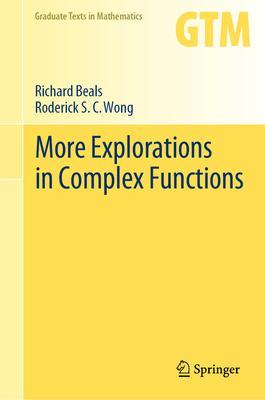More Explorations in Complex Functions

More Explorations in Complex Functions
More Explorations in Complex Functions is something of a sequel to GTM 287, Explorations in Complex Functions. Both texts introduce a variety of topics, from core material in the mainstream of complex analysis to tools that are widely used in other areas of mathematics and applications, but there is minimal overlap between the two books. The intended readership is the same, namely graduate students and researchers in complex analysis, independent readers, seminar attendees, or instructors for a second course in complex analysis. Instructors will appreciate the many options for constructing a second course that builds on a standard first course in complex analysis. Exercises complement the results throughout. There is more material in this present text than one could expect to cover in a year's course in complex analysis. A mapping of dependence relations among chapters enables instructors and independent readers a choice of pathway to reading the text. Chapters 2, 4, 5, 7, and 8 contain the function theory background for some stochastic equations of current interest, such as SLE.
The text begins with two introductory chapters to be used as a resource. Chapters 3 and 4 are stand-alone introductions to complex dynamics and to univalent function theory, including deBrange's theorem, respectively. Chapters 5--7 may be treated as a unit that leads from harmonic functions to covering surfaces to the uniformization theorem and Fuchsian groups. Chapter 8 is a stand-alone treatment of quasiconformal mapping that paves the way for Chapter 9, an introduction to Teichmüller theory. The final chapters, 10-14, are largely stand-alone introductions to topics of both theoretical and applied interest: the Bergman kernel, theta functions and Jacobi inversion, Padé approximants and continued fractions, the Riemann--Hilbert problem and integral equations, and Darboux's method for computing asymptotics.PRP: 790.41 Lei
Acesta este Pretul Recomandat de Producator. Pretul de vanzare al produsului este afisat mai jos.
711.37Lei
711.37Lei
790.41 LeiLivrare in 2-4 saptamani
Descrierea produsului
More Explorations in Complex Functions is something of a sequel to GTM 287, Explorations in Complex Functions. Both texts introduce a variety of topics, from core material in the mainstream of complex analysis to tools that are widely used in other areas of mathematics and applications, but there is minimal overlap between the two books. The intended readership is the same, namely graduate students and researchers in complex analysis, independent readers, seminar attendees, or instructors for a second course in complex analysis. Instructors will appreciate the many options for constructing a second course that builds on a standard first course in complex analysis. Exercises complement the results throughout. There is more material in this present text than one could expect to cover in a year's course in complex analysis. A mapping of dependence relations among chapters enables instructors and independent readers a choice of pathway to reading the text. Chapters 2, 4, 5, 7, and 8 contain the function theory background for some stochastic equations of current interest, such as SLE.
The text begins with two introductory chapters to be used as a resource. Chapters 3 and 4 are stand-alone introductions to complex dynamics and to univalent function theory, including deBrange's theorem, respectively. Chapters 5--7 may be treated as a unit that leads from harmonic functions to covering surfaces to the uniformization theorem and Fuchsian groups. Chapter 8 is a stand-alone treatment of quasiconformal mapping that paves the way for Chapter 9, an introduction to Teichmüller theory. The final chapters, 10-14, are largely stand-alone introductions to topics of both theoretical and applied interest: the Bergman kernel, theta functions and Jacobi inversion, Padé approximants and continued fractions, the Riemann--Hilbert problem and integral equations, and Darboux's method for computing asymptotics.Detaliile produsului








